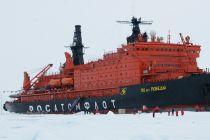50 Let Pobedy icebreaker
50 Let Pobedy icebreaker current position
The current location of 50 Let Pobedy icebreaker is in North Russia (coordinates 72.61281 N / 73.64194 E) cruising en route to ARCTIC. The AIS position was last reported 13 minutes ago.
Current PositionSpecifications of 50 Let Pobedy icebreaker
| Year of build | 2007 / Age: 18 |
| Flag state | Russia |
| Builder | Baltiysky Zavod/Baltic Shipyard (St Petersburg, Russia) |
| Class | Russian nuclear icebreaker (Arktika-class, Project 10520) |
| Ferry route / homeports | Murmansk |
| Engines (power) | OK-900A nuclear reactors (342 MW / 458630 hp) |
| Propulsion power | 52.8 MW / 70806 hp |
| Speed | 21 kn / 39 km/h / 24 mph |
| Length (LOA) | 151 m / 495 ft |
| Beam (width) | 30 m / 98 ft |
| Gross Tonnage | 23440 gt |
| Passengers | 64 - 128 |
| Crew | 140 |
| Decks | 8 |
| Cabins | 64 |
| Decks with cabins | 4 |
| Sister-ships | Arktika (1975), Sibir (1977), Rossiya (1985), Sovetskiy Soyuz (1990), Yamal (1992) |
| Owner | Russian Federation (via FSUE Atomflot) |
| Operator | Rosatom (Rosmorport), Quark Expeditions, Noble Caledonia, Poseidon Expeditions |
50 Let Pobedy icebreaker Review
Review of 50 Let Pobedy icebreaker
The 2007-built NS 50 Let Pobedy ("ледокол 50 Лет Победы," translated as "50 Years of Victory") is a nuclear-powered icebreaker owned by the Russian Federation. It was the largest nuclear-powered icebreaking vessel in the world until it was surpassed by the NS Arktika (2020-built/LK-60Ya-class). "NS" stands for "nuclear ship."
The vessel (IMO number 9152959) is Russian-flagged (MMSI 273316240) and registered in Murmansk.
The sistership Sovetskiy Soyuz (1990) was decommissioned in 2014.
Other Russian icebreaking cruise ships include Akademik Ioffe, Akademik Sergey Vavilov, Kapitan Dranitsyn, and Kapitan Khlebnikov.
In addition to 50 Let Pobedy, the list of other Russian nuclear icebreaker ships includes Taymyr (1989), Vaygach (1990), Yamal (1992), Arktika (2020), Sibir (2021), Ural (2022), Yakutia (2024), Chukotka (2026), Rossiya (2027/Project Leader), Stalingrad (2028), Leningrad (2030), and Sevmorput (1988/Cargo ship).
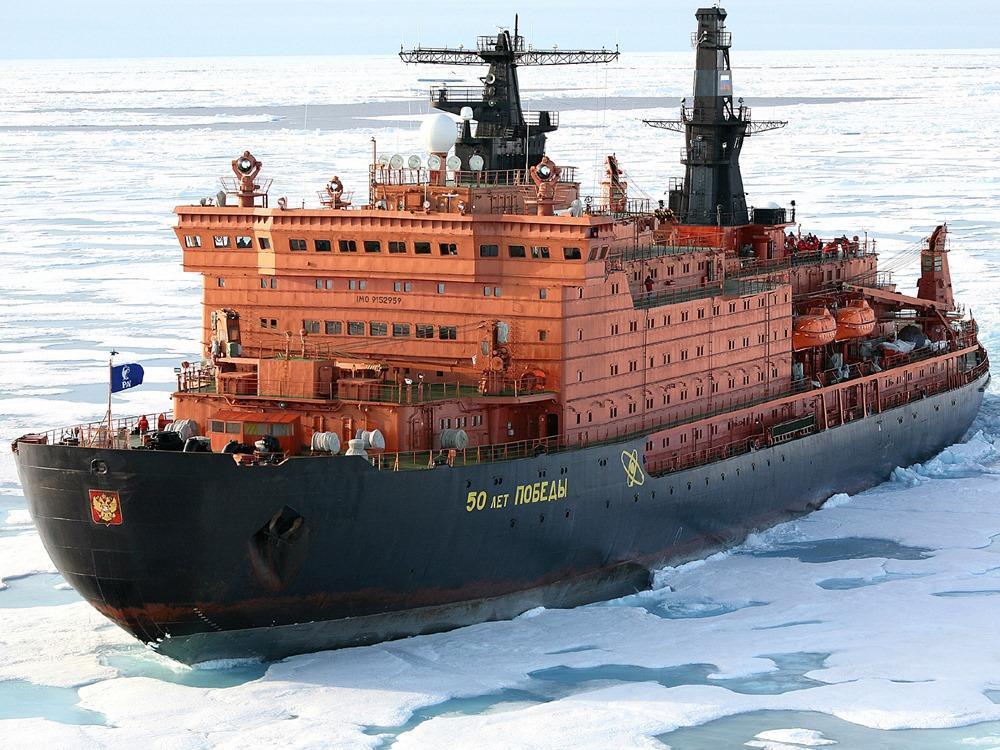
The project was launched on October 4, 1989, at Baltic Works, Leningrad, USSR (now Sankt-Petersburg). Initially, the vessel was named NS Ural. In 1994, work was halted due to a lack of funds, leaving the icebreaker abandoned by the 50th anniversary of Victory Day in 1995. However, construction resumed in 2003.
On November 30, 2004, a fire broke out aboard the ship, and all workers had to be evacuated. The fire crews battled the fire for about 20 hours before bringing it under control, with one worker requiring hospitalization.
By early 2007, the 50 Let Pobedy icebreaker was finally completed after the 60th Anniversary. On February 1, 2007, the vessel sailed into the Gulf of Finland for two weeks of sea trials. Upon completing the trials, the 50 Let Pobedy returned to the Saint Petersburg Baltic shipyard and began preparations for her maiden cruise to Murmansk. The new build demonstrated superior icebreaker characteristics, such as a top speed of 21.4 knots (40 km/h; 25 mph) and exceptional maneuverability. On April 11, 2007, 50 Let Pobedy arrived at her homeport, Murmansk.
The 50 Let Pobedy icebreaker is an upgraded version of the Arktika-class. The vessel, which is 524 feet long and 98 feet wide with a displacement of 25,840 metric tons, is designed to break through ice up to 5 meters (16.4 feet) thick.
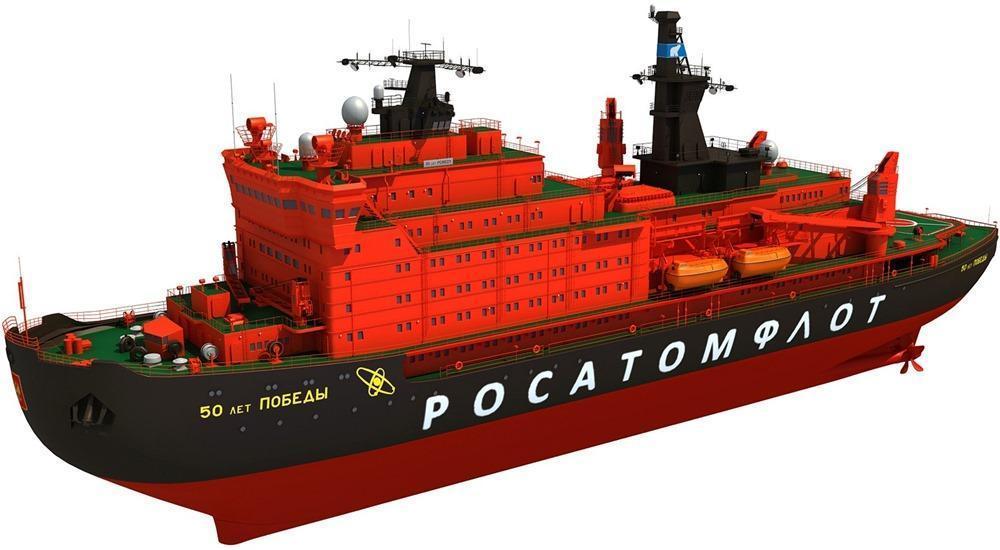
The 50th Anniversary of Victory project was experimental, marking the first time in Russian icebreakers' history that a spoon-shaped bow was featured. The designers predicted that such a shape would enhance the vessel's efficiency in breaking ice. The 50 Let Pobedy icebreaker is equipped with a new digital automated control system. Her biological shielding complex was modernized and re-certified by the State Commission. Additionally, a brand-new ecological compartment was created.
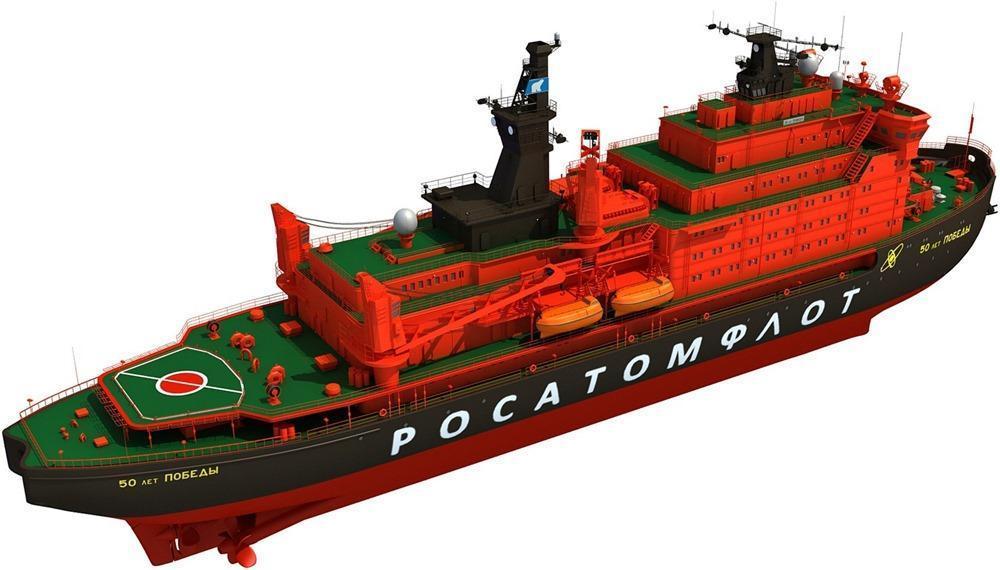
The ship boasts an exercise/athletic facility, restaurant, library, swimming pool, massage facility, and music salon for the crew's use.
Itineraries
Since 1989, Russian nuclear-powered icebreakers have been used for cruise tourism, carrying wealthy travelers to the North Pole. The fares can reach up to USD 35,000 per person for a 3-week cruise. The 50 Years of Victory ship has a dedicated deck for passenger accommodations, specifically customized for tourists.
In 2008, Quark Expeditions chartered the vessel for expeditions to the North Pole. The maiden voyage of the 50 Let Pobedy icebreaker to the North Pole embarked on June 24, 2008, from Murmansk. The ship carried 128 passengers in 64 cabins across 5 categories. In 2008, the vessel completed three expeditions to the North Pole for the polar adventure company.
Besides Quark Expeditions, the ship is also regularly chartered by the travel companies Noble Caledonia (UK) and Poseidon Expeditions (Russia). Since 2001, Poseidon Expeditions has specialized in polar cruises to European Arctic destinations, including the North Pole and Russian Arctic territories. The company charters exclusively Russian icebreakers, as well as ice-strengthened cruise ships.
- A group of eclipse chasers used the icebreaker to observe the August 1, 2008 eclipse. On July 21, 2008, they departed from Murmansk and reached the North Pole four days later, setting a speed record for the ship.
- As of February 2013, the company was listing 50 Years of Victory in its fleet and offering it for North Pole cruises, along with Poseidon Expeditions. The icebreaker reached the North Pole on July 30, 2013, for the 100th time in icebreaker navigation history.
- In October 2013, in the lead-up to the "2014 Winter Olympics" (February 7-23, held in Sochi, Russia), the nuclear ship carried the Olympic Flame to the North Pole.
Following the Coronavirus crisis, in 2021, the ship was chartered by Poseidon Expeditions for two North Pole voyages. Departing July 10-22, and July 21-August 2, both polar cruises were open for booking by Russian residents only. The 13-day "Top of the World" itinerary included scenic coastal navigation and exploration of the Franz Josef Land Archipelago (192 islands with abundant wildlife and stunning scenery). For the voyages, Poseidon hired 14 expedition staff, including polar experts, historians, marine biologists, geologists, and glaciologists.
In July 2021, Poseidon Expeditions scheduled three icebreaker cruises for 2022 (departures July 10-22, July 21-August 1, and August 1-13). Prices start at USD 30,395 (EUR 25,620/GBP 21,985) per person with double occupancy and an Early Booking discount (for bookings made by October 31, 2021). Poseidon's fares include a pre-cruise hotel (in Murmansk, Russia), all transfers, helicopter rides, land tours/excursions, onboard entertainment and lectures, and parkas.
NS 50 Let Pobedy Vessel Details
NS 50 Let Pobedy belongs to the Arktika-class nuclear ships, which were, until 2017, the world's largest and most powerful ever constructed. The ship is one of six vessels in this class, alongside Sibir (1977-1992), Arktika (1975-2008), Rossiya (1985-2013), Sovetskiy Soyuz (1990), and Yamal (1992).
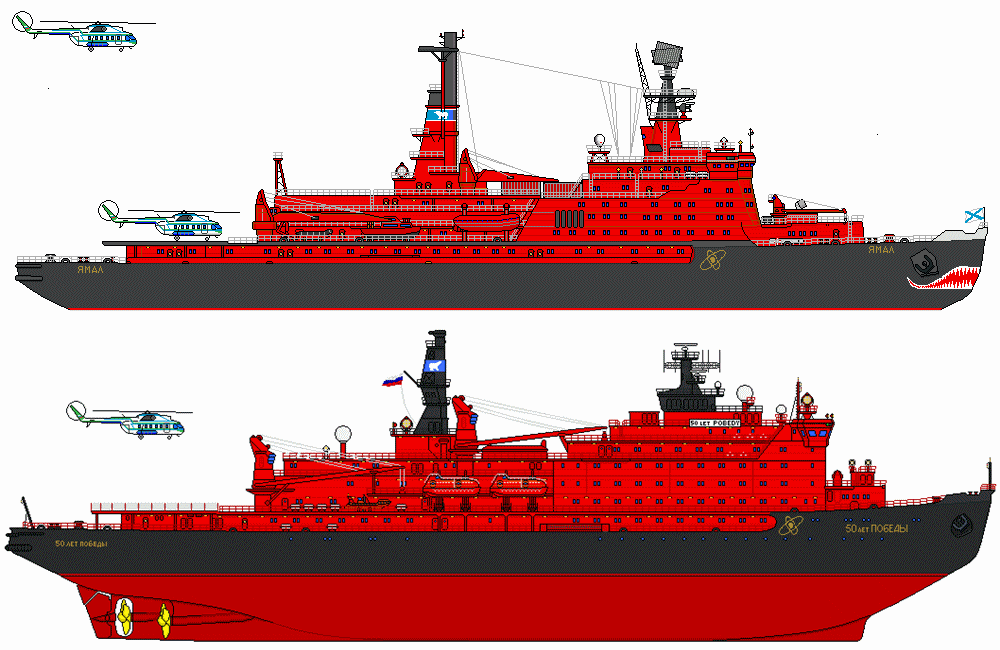
The vessel has one dining room, sauna, library, auditorium, passenger lounge, volleyball court, gymnasium, one heated indoor swimming pool, infirmary, one elevator, and one helipad (helicopter deck) with a Mi-2 transport helicopter.
- DWT Deadweight Tonnage: 3,505 tons
- Displacement Tonnage: 25,840 tons
- Max Draft: 11 m (35 ft)
- Icebreaking Capacity: 5 m (16.4 ft)
- Ice Class: LL1
- Range: Unlimited (4 years endurance)
- Powerplant: 2x OK-900A nuclear reactors (each 171 MW, or combined 342 MW power output)
- Propulsion: Turbo-electric, 3 shafts, 3 electric motors (17.6 MW output each, or 52.8 MW combined power output)
Note: In cases of poor AIS coverage, tracking the vessel's current location may be impossible. You can view CruiseMapper's list of all icebreakers and ice-breaking research ships in the "itinerary" section of our Icebreakers hub. All states and their fleets are listed there.
50 Let Pobedy icebreaker ship related cruise news
- Cruise Industry

VIDEO: Ponant's Le Commandant Charcot meets Russia's nuclear icebreaker 50 Let Pobedy near North...
In the Russian Arctic, the 150-m icebreaking cruiser Le Commandant Charcot crossed paths with the Russian nuclear-powered icebreaker 50 Let Pobedy/50...
August 22, 2023 - Accidents
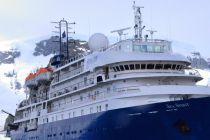
Poseidon Expeditions cancels Summer 2022 polar programs in Russian territorial waters
Poseidon Expeditions (fleet) announced that it had cancelled its Summer 2022 polar programs in Russian territorial waters. This affects a total of 7...
March 20, 2022 - Cruise Industry

Poseidon Expeditions restarts North Pole icebreaker cruises aboard 50 Years of Victory on July 10
Poseidon Expeditions announced the resumption of its North Pole icebreaker cruises aboard the nuclear-powered 50 Let Pobedy (50 Years of Victory...
July 3, 2021 - show more news
Other Rosatom-Rosmorport Russia cruise ships
50 Let Pobedy icebreaker Wiki
One of Russia's icebreaker cruise ships, 50 Let Pobedy (50 Years of Victory), is the world's largest nuclear-powered icebreaker ever built. The vessel's name celebrates the 50th anniversary of the USSR's victory in WWII. Construction of the nuclear ship began on October 4, 1989. Initially named "NS Ural," the project was halted in 1994 due to a lack of funds, shortly after the "perestroika" period. By the 50th anniversary of Victory in 1995, the vessel was left abandoned. However, construction resumed in 2003, and the ship was finally completed in 2007.
Since 1989, nuclear-powered icebreakers have been used for cruise tourism, carrying passengers to the North Pole in Russia's Arctic territories. Cruise prices can soar to USD 25,000 for a three-week voyage (over USD 1,000 per person per day). The 50 Years of Victory ship has a dedicated cabin deck for tourists. Quark Expeditions chartered the ship for the first time in 2008. As of February 2013, the company listed the ship in its fleet and offered cruises to the North Pole. Another operator of the vessel is the company "Poseidon Expeditions." On July 30, 2013, during one of Poseidon Expeditions' voyages, the ship reached the North Pole for the 100th time in Arctic icebreaker travel history. In October 2013, 50 Years of Victory also carried the Olympic Flame to the North Pole.
50 Years of Victory's cruise itinerary program offers polar expedition voyages in the Russian Arctic territories, departing from Helsinki, Finland. Russia's nuclear fleet of icebreaking vessels is used exclusively in the Arctic Ocean to escort merchant ships and assist research stations floating in the ice-covered waters north of Siberia. These ships are also used for scientific and Arctic cruise expeditions. The Russian nuclear icebreakers must operate in ice-cold waters to effectively cool their reactors.
On August 13, 2017, 50 Let Pobedy departed from Murmansk on an itinerary that retraced the route of the Russian North Pole expedition conducted on the old Arktika icebreaker in 1977 (August 9-22). 50 Let Pobedy embarked on the anniversary voyage with about 100 passengers, including some from the 1977 expedition. On August 17, 1977, the old Arktika reached the North Pole under Captain Yury Kuchiyev. The 2017 expedition also reached the planet's northernmost point on August 17.
Below is an example of a cruise itinerary for the icebreaker, departing from Helsinki. The 11-night/12-day round-trip cruise is themed "North Pole: Ultimate Arctic Adventure." Prices start from around USD 34,300 per person.
| Date / Time | Port |
|---|---|
| 22 Jul | Departing from Helsinki, Finland |
| 22 Jul | Departing from Murmansk, Arctic Russia |
| 23 Jul | Barents Sea |
| 24-25-26 Jul | Pack Ice Cruising |
| 27 Jul | North Pole |
| 28 Jul | Pack Ice Cruising |
| 29-30 Jul | Franz Josef Land (exploring) |
| 31 Jul | Pack Ice Cruising |
| 01 Aug | Barents Sea |
| 02 Aug | Murmansk |
| 02 Aug | Arriving in Helsinki |
In 2019, in addition to the Sea Spirit ship, Poseidon Expeditions also chartered 50 Years of Victory for the "Top of the World" icebreaker cruise itinerary. Departures were scheduled for July 7, 18, and 29.
Poseidon Expeditions' 2021 icebreaker cruise (Top of the World) is scheduled for July and August aboard the 50 Years of Victory. This marks Poseidon Expeditions' 20th icebreaker-charter season to the North Pole (since 2001), having hosted over 4,600 polar travelers. The 2021 icebreaking voyages are scheduled for July 10-22, July 21-August 2, and August 1-13. Fares include an overnight pre-cruise hotel in Murmansk, all transfers (to/from the ship and airport), helicopter tours, and onboard gratuities.
NS 50 Let Pobedy Icebreaker Vessel Details
Before boarding the ship, Quark Expeditions takes passengers through a high-security nuclear facility, similar to those used on Russian nuclear submarines. The Pobedy ship is equipped with two nuclear reactors capable of producing 74,000 horsepower. 50 Years of Victory was an experimental project, as it was the first Russian icebreaker ship to feature a spoon-shaped bow. As predicted by the designers, the innovative hull shape increased the ship's efficiency in breaking the Arctic Ocean ice. The vessel is capable of breaking through ice up to 5 meters (16 feet) thick. The 50 Let Pobedy icebreaker is an upgrade of the Arktika-class vessels in the Russian Arctic fleet.
- Besides 50 Years of Victory, the list of Quark Expeditions ships also includes Kapitan Khlebnikov (icebreaker), Ocean Diamond, Ocean Endeavour, Ocean Nova, and Ocean Adventurer.
- In addition to 50 Let Pobedy, other Russian icebreaker cruise ships include Akademik Ioffe, Akademik Sergey Vavilov, Kapitan Dranitsyn, Kapitan Khlebnikov, and the nuclear ship Yamal.
- The list of other Russian nuclear icebreaker ships includes Arktika (2017), Rossiya, Sibir (2021), Sovetskiy Soyuz, NS Taymyr, Ural (2022), NS Vaygach, NS Yamal, and NS Sevmorput (cargo ship).
Since 2008, the ship has been captained by Dmitriy Lobusov, who has been a part of Russia's icebreaking fleet since 1988.

